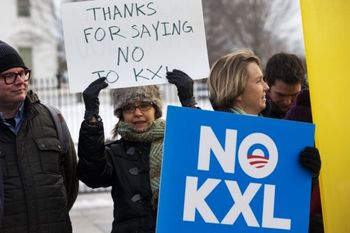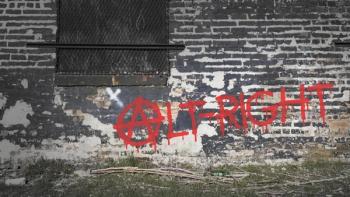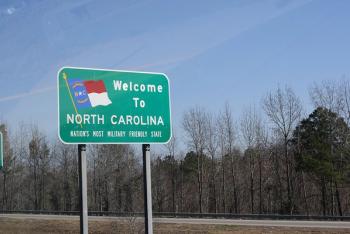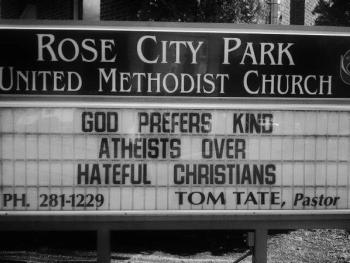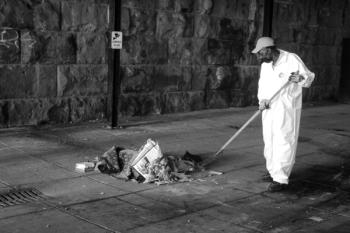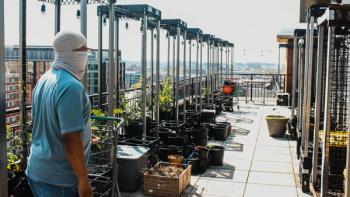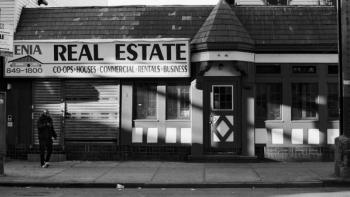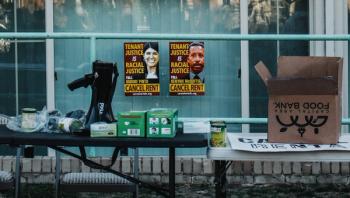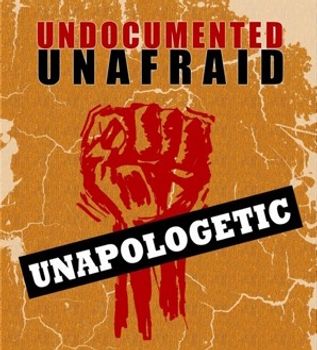
Addressing America’s Homelessness and Squalor: What We Could Do If We Cared
2021-04-19
by Eleanor Goldfield
This article originally appeared on Mint Press News. Please check out their site for more radical and independent journalism!
“I wanna know where the $2.5 million is – that’s my reaction.” Muhsin Boe Luther Umar — or as we call him, Uncle Boe — throws his hands up and shakes his head. In his role as both Resident Council President at Garfield Terrace and D.C. Advisory Neighborhood Commission (ANC) 1B03 Member, he’s had more than his fair share of dealings with D.C. Housing Authority (DCHA). So I had asked him what his reaction was upon hearing about the recent audit of three DCHA contracts, which found nearly $1.4 million in wasted funds.
“You’re talking $1.4, I’m talking about $2.5 million spent on one senior housing building,” he says. Back in 2018, D.C. is said to have spent $2.5 million on “weatherizing” improvements for Garfield Terrace, “$975,000 spent to keep the roof from leaking – it’s still leaking,” Boe says, pointing to the water stains on the ceiling. He went on:
That money was supposed to put new light fixtures in the building, which you don’t see. That money was supposed to redo the rooftop area. It wasn’t done. And solar panels that don’t work. And if it’s working, where’s that money going? There’s a monthly payout for solar programs – so where is that money? Or if it don’t work, why doesn’t it work? Where is the money?”
We’re standing in the community room on the ninth floor of Garfield Terrace, a senior-citizen public housing building in D.C.’s Ward 1. Cans and boxes of non-perishable food sit ready to give out to residents. Art projects dot the tables and Boe buzzes from the newly painted kitchen to the seeding room to show me all the veggies, fruits and herbs getting ready for potting in the rooftop garden. On either side of the community room, spring is budding and blooming – from strawberries to lemon cucumbers to a ridiculously delicious tasting salad he has me try, chuckling at my wide-eyed reaction.

The rooftop is one of Boe’s many projects, along with making benches out of discarded shipping pallets, fine-tuning and improving the outdoor wheelchair accessible garden and hangout spot, and putting together new ideas for arts and crafts that the seniors can do to keep up their mental and physical acuity.
There’s also the COAN program, or “Check On A Neighbor,” which started soon after the pandemic and works just how it sounds: neighbors checking on neighbors to make sure needs are met, that folks are doing okay and have the resources and information they need to stay safe and healthy. Furthermore, with collaborative community partnerships, Boe estimates that some 60,000 meals have been served at Garfield Terrace. “And we served meals every day,” he says. This was something that DCHA was supposed to have a handle on, Boe says, but ended up failing miserably at. “They contracted with a company named Terrific Inc., which falsified signatures, making millions of dollars saying that they were doing stuff that wasn’t being done,” he tells me. Terrific Inc. eventually left the building, but theirs is just one of the many stories and ways in which DCHA has battled Boe and his plans.
Housing Authority with the attitude of a weed-whacker
Last year, DCHA locked residents out of the community room, barring access to the kitchen and rooftop garden. They’ve called the cops on Boe, claiming he was causing a disturbance at the building only to find out that he was hundreds of miles away in Alabama. Whoops. Meanwhile, in his glass house throwing stones, DCHA Executive Director Tyrone Garrett is in the crosshairs of a whistleblower lawsuit after a former employee claimed that she was fired last August for raising concerns that Garrett was “neglecting the health and safety of DCHA employees and residents, violating the terms of her contract, and protecting his ‘friends,’ who hold high ranking positions in DCHA.”
This wouldn’t come as much of a surprise to the folks at Garfield Terrace. On top of the improvements they’ve contracted for but that have yet to materialize, DCHA owes Garfield Terrace roughly $15,000 in supplies that they green-lit back in 2018 and that would have prepared the seniors for the onslaught of the pandemic.
“We’re owed $29,000, and we were only planning on spending $15,000,” Boe says. “Podcasting and studio equipment, laptops and desktops for the seniors, printers, an upgrade to the kitchen, patio furniture for the rooftop, stuff to do hydroponics and aquaponics,” he specifies, counting them off on his fingers. “And this was in 2018. If we would’ve gotten that, we’d already have a garden up and running so that people could eat healthy. We were supposed to get sewing machines, so we could’ve made our own masks. We would’ve been prepared for the pandemic – for remote connection. We would’ve had the materials to engage, and protect the seniors,” he says.
Taking the fight to City Hall
As we continue our conversation, Boe reminds me that he still plans on getting that money. The fact that he can fill so many gaps left by DCHA doesn’t mean he’ll stop calling them out for their failures. And their reactions up till now show that they notice him. As the saying goes, “…then they fight you, then you win.”

Still, it’s a battle hard fought and even more hard won. While those officially tasked with protecting and serving the people fight our work to protect and serve our communities, the question arises as to how to hold them accountable – how to watch the watchers and get what we’re owed. To be sure, there’s not just one answer to that question, just as there isn’t one cure-all tactic. But regardless of where our expertise and energies lie, we should expect a messy morass made thick by reams of paperwork, tangential switch-backs and roadblocks.
Take, for instance, audits. Now audits are pretty routine, be they independent audits, like the aforementioned one in D.C. or the audits via the Office of Inspector General (OIG). Indeed, outside of the ready OIG list, all you have to do is google a random city and “audit” and you’ll find plenty of links to reports on misuse, fraud, misappropriation and more. Still, just because something is plentiful doesn’t mean it’s accessible. This DCHA audit, for example, has yet to be released to the public. When I spoke to Mitch Ryals, the journalist who broke the story on the $1.4 million audit, he said that “DCHA still hasn’t disclosed the audit despite an FOIA request.” According to an email sent to Ryals by DCHA spokesperson Tony Robinson, the DCHA doesn’t think the audit is legitimate and asked Ryals to not publish the story. Sure, that sounds legit.
Still, housing audits are just one of many keyholes through which to glimpse the inner workings of housing authorities. Deborah Thrope is Deputy Director of the National Housing Law Project (NHLP), a housing justice and tenants rights organization. In order to bolster advocacy for tenants and recommendations for housing authorities, she tells me that NHLP pulls from a lot of sources, but it’s hardly a one-stop shop. She explains:
Only some of [the data the Department of Housing and Urban Development, HUD collects] is accessible to the public, and the data it collects and publishes is sometimes not the data that is most helpful for advocates and tenants. In that case, tenants and advocates must rely on local housing authorities for the data, which can be challenging if the housing authority is unwilling to provide it. This results in unnecessary delays to collect the data because advocates and tenants have to do public record act requests.”
Now, there’s the obvious question of who, aside from experts and journalists, has the time or energy to dig into housing data or submit public record requests, and why there isn’t generally more transparency and accessibility. However, there’s also the question of what’s happening with all this data. After all, what’s the point of collecting performance information unless you expect to address and/or change that performance? Without action, these reports become paper-thin illusions of intent.
“So, that’s the problem. A lot of times these things just go into the abyss,” Thrope says. “There are over 4,000 housing authorities,” she explains, “and as far as I know there’s no standard operating procedure for following up to ensure that recommendations have been followed.” She emphasizes that the recommendations found in audits are also just that – recommendations. Enforcing a suggestion is as flimsy as it sounds, and whether or not the housing authority takes action to address the issues found in an audit seems to be up to them.
I reached out to the HUD Press Office with these same questions and got a reply oddly specified for the Cleveland Public and Indian Housing Office (PIH) stating that the field office conducts “follow-up activities for audits,” helps to develop “appropriate management corrective action strategies,” issues “management decisions for audit findings within six months after receipt of the audit report,” and ensures “the public housing authority takes appropriate and timely corrective actions.”
As to my question of how HUD ensures those corrective actions are taken, the response was simply to see the “established guidance outlined” earlier. The response doesn’t build overwhelming confidence – even in the Cleveland PIH which was for some reason the highlight of their reply. It seems that something is getting lost in communication, and not just between me and the press office.
Very selective foot-dragging
To take an example, in February of this year, a report by the OIG showed that for decades HUD knew about and ignored lead poisoning at a public housing project in East Chicago, Indiana. Back in 1985, the EPA discovered high levels of lead at the West Calumet Housing Complex, built atop a former lead smelting plant in 1972 – what a coincidence! Fast forward to 2009 and the development was declared a Superfund site and was finally demolished in 2019. One might wonder why it took 24 years to classify a lead-soaked heap as a Superfund site or why it took another 10 years on top of that to finally move residents and demolish the building. Well, then you might also wonder why the HUD field office in Indianapolis responsible for conducting environmental reviews for the building, didn’t. They also failed to alert residents to the unsafe environmental conditions in which they were living.
The report goes on to point out that thousands more public housing projects built on contaminated land could be at risk of similar mass poisonings. It’s no surprise when you consider the fact that 70% of hazardous waste sites officially listed on the National Priorities List are located within one mile of federally assisted housing.

Source | Earthjustice
And yet, a report done last year by the Shriver Center on Poverty Law states that housing agencies routinely approve new construction and “substantial rehabilitation while ignoring known environmental contamination.” After all, there’s a growing need for affordable housing and we couldn’t possibly stem the construction of luxury apartments and homes so let’s just throw ’em into contaminated cesspools.
Build Back Better for Whom?
A mid-March report by the National Low Income Housing Coalition found that there’s “a shortage of nearly seven million affordable and available rental homes for extremely low-income renters, those with incomes at or below the poverty level or 30% of their area median income.” Based on the fact that some eight million Americans plummeted into poverty between May and October of 2020, my guess is that seven million is a conservative estimate.
Meanwhile, in January 2020, the Wall Street Journal estimated that builders were on track to build 371,000 new units of housing – more than any year since the 1980s – with 80% of those being luxury or “Class A” properties. And as millions of Americans struggle to find housing or stay in their homes (as I covered in the previous housing article) a recent Boston Globe investigative report digs into what they call “wealth storage” in the form of luxury real estate. Essentially, the richest of the rich purchase condos through anonymous shell companies in order to house their millions rather than themselves and their families.
The examples given are grotesque and staggering. For instance, in 2014, 54% of all real-estate purchased in New York City for more than $5 million was bought by anonymous shell companies. Some 900 condos in Manhattan, the majority of which are owned by anonymous shell companies, are worth the equivalent of 20,000 average American homes. In Boston, massive luxury projects spring up like gilded pimples across the city, here again with anonymous shell company ownership – in one building, close to 80% of the units were anonymously owned.
The mere thought of 80% empty buildings when thousands are homeless is enough to send blood shooting out of your ears – but wait, it gets worse. The sheer scale of these projects requires a shit ton of material and of course energy. After all, you can’t have a luxury condo entryway that isn’t properly lit – even if only two people see it. It goes so far that for one project in Boston a natural gas pipeline was constructed solely to service the units of that one building.
Across the country in the San Marcos Foothills in Santa Barbara County, California, community members have mounted a campaign to save the beautiful public wildlife preserve from being decimated by an eight-home luxury construction project (yes, that’s eight (8) homes on 104 acres). The scale and arrogance of these projects highlight yet another casualty of luxury homes: public space and amenities – parks, schools, libraries, trails, and more. The goal is shuttered wealth, in all senses of that word – shuttered from taxes, shuttered from the unwashed masses.
In the shadow of these empty high-rises, these sparkling sentinels of peak capitalism, vast poverty knocks on bolted doors. A quick internet search will show you row after row of ‘CLOSED’ signs at housing authorities across the country. Here in D.C., the public housing waiting list “is currently closed to new applicants. There is no scheduled time to re-open the waitlist.” The Panama City Housing Authority has a closed waiting list notice from July of 2018.
From big cities and regions like Oakland Housing Authority and Orange County Hosing Authority, to smaller ones like Windsor Housing Authority in Connecticut and Kelso, Washington Housing Authority (which has had a closed waiting list since March of 2018), public housing may as well be a luxury condo for these folks in need. Based on the latest report by Opportunity Starts At Home, only 5.2 million households get federal rental assistance “to afford modest housing.” Four in ten low-income people are homeless or pay over half their income in rent, and some 16 million households in need are shut out of the bare minimum in rental assistance because of funding limits.
Thrope echoes this point in our conversation, making it clear to me that while her work focuses on pushing housing authorities to do better, there is a serious funding issue to contend with from the outset:
Housing authorities are extremely under-resourced, so they’re running programs for the most part on a shoestring. You want the housing authorities to do the right thing, but what is the stick – because cutting funding really isn’t an option. Because families need support. If you cut the funding, they’ll just serve less people.”
Follow the money — bring your sick-bag
Indeed — as Diane Yentel, president and CEO of the National Low Income Housing Coalition, (NLIHC) testified to Congress in 2019 — “adjusting for inflation, the federal budget authority for housing assistance programs in the 1970s was nearly three times more than it is today, despite the significant growth in the number of low-income renters eligible for housing assistance.” To quote Boe:
Where is the money?”
Put simply, it’s misappropriation on a large scale.
It’s tax breaks for building luxury condos and letting those sit empty for the sake of shuttered wealth — then incentivizing the construction of more, devastating both environment and community.
It’s $107.5 billion dollars more spent on police than on public housing.

It’s a military budget, which Biden proposed increasing, bolstering the world’s largest terrorist organization and largest polluter in one fell swoop. I guess that’s ‘building back better.’
And while it’s become somewhat cliché to point out how severely grotesque our military budget is (and that’s just the official military budget – not even stuff like the $21 trillion that’s gone ‘missing’), we have to keep pointing this out – broken record or repetitive nag though we may be. A complacent passivity for $753 billion spent on each year of death and destruction would be unacceptable even if everyone in the country had a luxury condo, free healthcare and a fair-wage job planting trees.
It is of course, even more unacceptable since that is hardly the case. Still, the military budget is but the most glaring and macabre of money pots to pull from. In this land of consumption, there are many more.
A few simple, obscene cost comparisons
For instance, an op-ed from May of last year points out that “the nation’s homeless population could be housed for $10 billion a year — less than the price of one aircraft carrier.” Between 2000 and 2018, Amazon – that’s one company — has received more than $1 billion in tax credits. Every year, American corporations dodge some $70 billion in taxes via the use of offshore tax havens. Just the annual cost of the mortgage-interest deduction, another name for a tax subsidy for wealthy homeowners, is $77 billion – that’s every year! Hell, you could make more than $70 billion a year just by taxing the goddamn churches. How about some separation of church and state for once?
It would take less than half of that to pull more than 2 million children out of poverty. Isn’t that a thing that churches supposedly care about? The Children’s Defense Fund proposed housing vouchers for “all families with children with incomes below 150 percent of the poverty line, and for whom market rents are unaffordable.” This would come to roughly $22.3 billion annually, reducing child poverty by 22%.
Addressing our system’s deeply rotten and corrupt core
In other words, it’s not that we as a nation don’t have the money. It’s that the priorities on every rung of government are so painfully backwards.
It’s a combination of lack of funding in the right places and a lack of common sense, ethics, morals and/or a modicum of humanity when it comes to using that funding. Lest we forget, it was just a year and a half ago that then-Secretary of HUD Ben Carson was caught trying to buy $31,000 in office furniture. And let’s be honest, if you even get to the point where you’re spending $31,000 on office furniture, you shouldn’t be making decisions that affect people who make less than $31,000 in an entire year.
Likewise, there shouldn’t be a bill for $2.5 million in repairs when the roof is still leaking, when hallways and common spaces are in serious need of fixing.
There shouldn’t be recommendations for improvement – there should be deadlines for improvement.
There shouldn’t be questions about how much we can spend to house people, but rather how quickly we can get people into safe and comfortable homes.
And this is why piecemeal and shallow reforms won’t cut it – just as I wrote about in the previous article on housing. We need structural changes in order to address the deeply rotten and corrupt core of our system.
That takes time – it takes diversity of tactics. As Thrope says to me, “we’re always trying to think of creative ways to get housing authorities to comply with these recommendations, and in some cases requirements.” For Boe, a new tactic has been his position as an ANC member. “Being what you’d call an aggressive activist,” he says with a chuckle. “I’m not going away. It [the ANC position] gives we the people more leverage to be able to deal with DCHA. They gotta respect my position now.” However we advocate and fight for our communities, we gotta keep it up – we gotta grow and shift and build and spread – like the vines starting to climb on the trellis at Garfield Terrace’s rooftop garden.
From the south side of that garden, you can see the postcard view of D.C. – the Capitol, the Monument, cherry blossoms oozing color amidst the siege of gentrification. From the east side of the garden, you can see a brand new chic apartment building. Down the street there’s a Whole Foods. This is prime real-estate, and DCHA knows it. Last year a resident I met told me that her grandmother had once been a resident at Garfield Terrace – and back then it was the cream of the crop. It doesn’t take a house-flipping expert to see what’s at play here: make it deplorable, displace, raze, and that neoliberal dog whistle: build back better – for those who have the status to pay for better.
But Boe isn’t buying it and, as he shows me another outdoor space on the ground floor with overgrown concrete planters, he paints an idyllic picture of a vibrant garden retreat for residents, and neighbors. The antithesis of shuttered wealth – community. “Imagine it, sis,” he says, looking over at me, clearly smiling beneath his mask. “Not just for me, for us, for the whole community – and their kids, your kids and all of ’em, after I’m gone.”

